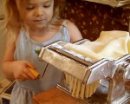Pasta
Simple all occasion meals can be based around pasta. Here is our basic recipe for pasta. You can substitute Spelt flour, whole wheat,rice or whatever grain that you like. During the mixing process, especially if you are using a Cusinart you may toss in fresh herbs. This makes an extremely nice dough that when shaped and cooked really lends itself to simple butter sauces and other light toppings.
The measurements for making pasta are never too precise. I go by feel. You want a dough that is somewhat dry, but when squeezed in your had will bind together forming a nice ball. The dryness will depend on what you are going to make with your pasta dough. If you are making linguini, fettucini, spagettini or similar long style then you need the dough on the dryer side. If you are going to make ravioli, tortellini or lasagne then a wetter dough is called for.
Okay, now for the ingredients. There are some variations that can be made and considered. If you are making pasta for drying or long term storage, then you can omit the eggs. If you are vegan and do not eat eggs then you may omit them too When omitting the eggs you will need to add more liquid.
There are a number of different flours that are used in the making of pasta. I already mentioned some alternatives but if you like pasta made from the traditional flours then you should invest in Durham wheat. It is a semolina flour very finely ground.I use straight Durham flour for tortellini and similar types of pasta. For the linguini types I like to blend in semolina with it. All purpose flour works well for dusting the board and the dough as it rolls out.
Ingredients
- 2 eggs (if you want egg noodles, just use the yolks and increase to 3)
- water or milk (this is added to desired consistency)
Add the dry ingredients to the Cusinart work bowl. If you are doing this by hand then I salute you,see the note at the bottom of the recipe for mixing by hand. Start the machine. Add the eggs one at a time while the machine is running. You may need to add a little water if the dough is to dry. I like to use milk sometimes instead of water. It will allow for a more tender pasta.
If you are making pasta to dry or you just don't want to use eggs all you need to do is add your liquid to the mix. No matter which you decide on doing the consistency is the key to an easy to handle pasta. What you want is a dough that will make a ball when squeezed together. If you allow it to ball up in the machine then you will find that it is too wet. You can remedy this by adding more flour as needed.
Rolling and Cutting- I work on a floured table and the real trick is to keep the dough on the dry side. This is extremely true if you are making angel hair pasta or similar types. nothing worse than pasta clumping up. I have a couple of Atlas machines that we use for all our pastas. Divide the dough into several pieces. Flatten them out by hand to start with. Set the machine at it's first setting, #1 with the Atlas or whichever setting is the largest. Now once it is run though, you need to fold it over and repeat the step again. I like to flour the dough as I do each pass. I try for nice long rectangular sheets. After about 4 passes I move the setting up two notches and repeat. I continue this moving the setting up till I arrive at the one the one I will use for my desired pasta.
Now is the fun time for the actual making the pasta. I like the fettucini for white sauces and with seafood. They make a number of different cutters for shapes/styles. Most of them are worthless. The ravioli one is almost useless. The basic shapes are the best anyway.
*note for by hand: You first need to pile up the dry ingredients and make what is called a well in the center. Add your eggs into the well and stir until incorporated into the flour. Messy process kids love to mix it this way.
